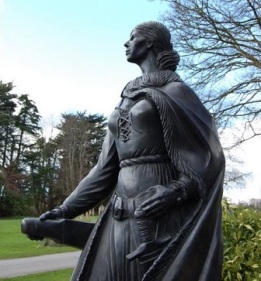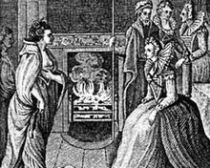Grace O’Malley, born in 1530, was from a seafaring family based around Clew Bay in Co.Mayo. Seafaring being a bit of a euphemism for piracy. Her family, with its main stronghold on Clare Island, reserved to itself the right to levy all vessels fishing off their coastline, no matter where they came from. Whether that was tax collecting or piracy is a moot point. To this day there are those who still see little distinction between the two pursuits anyway.
The only child of Eoghan Dubhdara and Maeve O’Malley, Grace was a bit of a tom-boy to say the least. She was flamboyant and belligerent. As a child she earned her famous nickname ‘Granuaile’ by cutting off her hair when her father refused to take her on an expedition to Spain on the spurious pretext that her long tresses might catch in the ship’s rigging. Thereafter she became known as ‘Bald Grace’ or Grainne Mhaol.
She was married twice and was rumoured to have had many lovers, although this was an accusation regularly levelled against powerful women during the 16th century. Her first husband was Donal an Cogaidh O’Flaherty – Donal of the Battle – whom she married at the age of 16. After his death Grace set her cap at the wealthy and influential Richard Bourke. He was known as Risteard an Iarainn either because he always insisted on wearing a coat of mail inherited from his Norman ancestors or because he controlled much of the iron manufacturing in Connacht. Or both.
Grace and Richard married under the Brehon Law, which, as it happened allowed a wife to divorce her husband. And, as it happened, that appears to have been exactly what happened. Grace, installed in Bourke’s ancestral pile, Rockfleet Castle, ended the marriage by the simple device of telling her husband ‘Richard Bourke I dismiss you’. But she cleverly kept the Castle.
Grace and her first husband, Donal O’Flaherty, didn’t make themselves very popular with the merchants of Galway who complained to the English court that the O’Malleys and O’Flahertys were behaving like pirates. Not that Granuaile confined her activities to her own back yard. Her revenue raising exercises ranged all along the south and west coasts.
She was, by and large, a supporter of rebellion, though she was not averse to helping out the English administration in Ireland when it suited her.
However, when her sworn enemy, the English governor of Connacht, Richard Bingham, kidnapped two of her sons and her half-brother in 1593 she took the unusual step of sailing to England to make the case for their release directly to Queen Elizabeth herself. It was, by all accounts, a memorable occasion with Grace dressed in the 16th century equivalent of creations by John Rocha and Phillip Treacy. The essential difference being that she also sported her own concealed dagger, de rigeur in the Tudor period, but calculated to ruin the line of a piece of 21st century couture.
Elizabeth was impressed by the Irish pirate Queen, politically empowered women being thin on the ground at the time. An accommodation was reached which didn’t last very long and resulted in a fleet being despatched to seek and destroy Granuaile’s power base. Between the time of her meeting with Elizabeth 1 and her death, probably in 1603, Grace threw her support behind the forces gathered by O’Neill and O’Donnell in the Nine Years War.
O’Malley has been feted in prose, poetry and music by artists as diverse as Shaun Davey, Patrick Pearse and the Sawdoctors. The Commissioners of Irish Lights have named not one but three vessels after her though the fact that the Asgard carried a figurehead of Grace didn’t stop it sinking in 2008.
An English expedition prepared to leave Galway to take on the might of Grace O’Malley, aka Granuaile, aka the Pirate Queen, 420 years ago, on this day.

